Teaching Philosophy

Teaching is a conduit for the empowerment of visual communication. At this moment, students of design should recognize that design will shape our future. Our choices can affect and change behaviors, deliver delight, or help clarify otherwise unclear information. The discipline of Communication Design has shifted beyond the commercial applications that dominated the 20th century, where designers play only a part in the end process of developing an idea, artifact, experience.
Designers today should be equipped to recognize their impact on culture, social, and economic systems. Many other fields have adopted design methods, particularly in design thinking, to embrace design as a catalyst for forward-thinking ideas. Still, without the expertise and specific knowledge of a visual designer, these ideas could fail to communicate.
Visual Communication Designers should understand basic foundational visual principles. Not only for aesthetic purposes but because color choices affect how we perceive content. Consideration of audience when making visual decisions is essential for the visual communication designer. Cultural meanings of typography and color add meaning to designs, age differences impact legibility, social context of the environment the system inhabits, and influence perception.
In typography, a visual communication design student will learn that they are not just selecting a font but giving form to language to inform, clarify, emphasize, and add pleasantries to what might otherwise deter, confuse, overwhelm, or cause disgust.
Language, in its written form, has developed with humanity. Understanding the technological implications that have influenced it and the power of dissemination of ideas that it has allowed is awe-inspiring. When I teach typography, I teach it from this perspective, interwoven with practical skill-based methods and terminology.
Technology is a tool, and while many people believe teaching design is to teach a particular program or skill, I find it necessary to teach how not to be afraid of using new tools. But to work with materials and tools as part of a process for exploration and discovery. Tools range from our hands to machines to coding languages, and students should be comfortable using the best tool for the problem.
Designers today should be equipped to recognize their impact on culture, social, and economic systems. Many other fields have adopted design methods, particularly in design thinking, to embrace design as a catalyst for forward-thinking ideas. Still, without the expertise and specific knowledge of a visual designer, these ideas could fail to communicate.
Visual Communication Designers should understand basic foundational visual principles. Not only for aesthetic purposes but because color choices affect how we perceive content. Consideration of audience when making visual decisions is essential for the visual communication designer. Cultural meanings of typography and color add meaning to designs, age differences impact legibility, social context of the environment the system inhabits, and influence perception.
In typography, a visual communication design student will learn that they are not just selecting a font but giving form to language to inform, clarify, emphasize, and add pleasantries to what might otherwise deter, confuse, overwhelm, or cause disgust.
Language, in its written form, has developed with humanity. Understanding the technological implications that have influenced it and the power of dissemination of ideas that it has allowed is awe-inspiring. When I teach typography, I teach it from this perspective, interwoven with practical skill-based methods and terminology.
Technology is a tool, and while many people believe teaching design is to teach a particular program or skill, I find it necessary to teach how not to be afraid of using new tools. But to work with materials and tools as part of a process for exploration and discovery. Tools range from our hands to machines to coding languages, and students should be comfortable using the best tool for the problem.
Objectives, Strategies
and Methodologies
Encourage Mastery of Core Design Principles
As a teacher of core foundations in Graphic Design Communication, it is my objective to encourage mastery of design principles and instill a historical and contemporary awareness of the graphic design field. My courses are taught with a mix of readings, lectures, and in class discussion and critique. Lectures are brief and introduce core design principles and contain contemporary examples of these principles in use. Exercises are incorporated that allow students to experiment with and try out the principles themselves. Readings range from current design education books written for beginning designers to influential texts from typographic Swiss masters such as Karl Gerstner.
Over the past two years, I’ve experimented with different ways of teaching these foundational skills in our curriculum. Responding to a changing landscape in graphic design education and careers, I have begun to combine traditional Bauhaus methods with human centered research and contextual approaches practiced in the field today. Instead of asking students in my Introduction to Graphic Design course to design black and white icons, I ask them to select a site and through observation methods look for opportunities to use visual language enhance peoples experience within the space. After designing the icons they must also imagine a scenario for usage. For example, one student chose a tatoo parlor, and then designed packaging for different hygiene artifacts that she observed being used at the tatoo parlor to apply an icon system too. This merges gestalt principles with a human centered design process.
A new addition to my typography courses as a reference and supplemental readings is Denise Gonzales Crisp’s book Graphic Design in Context: Typography. I have used this book to experiment with new methods of teaching type, asking students to draw from the world around them instead of just learning through abstract formal exercises. In my Introduction to Typography class students were prompted students to go look for examples of type that they found in their environments. Then as a class we organized the examples into categories of typographic styles and then discussed how each carried signifiers attached to cultural reference points through style and typography choices. This method brings context to the formal aspects of typography and engages students in an active learning environment.
Critical Thinking in Image Making Culture
Critique is one of the core methods I rely on to encourage critical thinking and knowledge exchange in my classroom. I lead critiques in an open, liberal format that encourages discussion about formal technique, cultural connections in fields other than design, and meaning and interpretation of one’s work. I allow students to comment, debate, ask questions and I interject when appropriate. I frequently challenge students to think beyond the easy answers to problems and look for solutions that are less obvious, more innovative, and inspiring.
Through critique methods I encourage students to develop a dialogue that questions traditional methods and process and promotes a more critical way of thinking. Whenever possible I point out similarities and cross overs between methods and processes in design and other disciplines.
It is these types of connections I hope will foster a deeper understanding of the relevance of how they approach graphic design and it’s broader implications in the world.
Development of an Authentic Process
One of the most important objectives I view in teaching design is the development of an individual process. I frame exercises and projects to help students hone in on and try out different processes and experiment with different formal results. These types of exercises allow for experimentation and understanding of form, the ability to work with shape, texture, contrast, color, and other core design principles that are a necessary skill in the success of a graphic designer today. While many students of graphic design graduate with digital skills and some interesting ideas, they lack a true understanding of form. This is a necessary in the oversaturated design market today, and what sets apart candidates for more prestigious design jobs.
I have had continued success with this in my Introduction to Graphic Design course with an exercise in which students are presented with a random everyday object such as combs, pencils or rubberbands. Students were asked to take the object home and explore its formal properties through photography, drawing, or mark making with the object itself. Instruction is given to approach the object as if you have never encountered it before and even break, melt, or deconstruct it however you see fit. This exploration forces students to experiment with techniques they may otherwise not of thought of using in design and discover formal properties through the act of a process.
Practice of Human Centered Research
In Fall 2017 I taught Design 7, our systems design studio for first semester seniors. In this course students tackle a semester long project that deals with a real world problem. This semester we worked with the Philadelphia Department of Public Health on designing for heat emergencies in Philadelphia. In this context I was able to bring my background in design research methods into the classroom and experiment with many of the techniques that I have practiced and found success with in my own work.
Some of the more successful exercises I introduced into the course were a quick brainstorming method of sketching out “wild and crazy ideas” early in the process. This exercise, although early in the process immediately opened up the students to thinking outside the box and consider how design can influence our social and cultural systems. The students carried this type of thinking throughout the course and some of the final projects included an emergency transportation line that worked with SEPTA’s existing system. Design deliverables included a map, signage system and game to introduce the new line to the communities that would benefit from its use.
Students were also able to incorporate direct observation into their research by riding SEPTA in the case of the prior mentioned project or going to specific neighborhoods that were in danger of problems during heat emergencies.
As a teacher of core foundations in Graphic Design Communication, it is my objective to encourage mastery of design principles and instill a historical and contemporary awareness of the graphic design field. My courses are taught with a mix of readings, lectures, and in class discussion and critique. Lectures are brief and introduce core design principles and contain contemporary examples of these principles in use. Exercises are incorporated that allow students to experiment with and try out the principles themselves. Readings range from current design education books written for beginning designers to influential texts from typographic Swiss masters such as Karl Gerstner.
Over the past two years, I’ve experimented with different ways of teaching these foundational skills in our curriculum. Responding to a changing landscape in graphic design education and careers, I have begun to combine traditional Bauhaus methods with human centered research and contextual approaches practiced in the field today. Instead of asking students in my Introduction to Graphic Design course to design black and white icons, I ask them to select a site and through observation methods look for opportunities to use visual language enhance peoples experience within the space. After designing the icons they must also imagine a scenario for usage. For example, one student chose a tatoo parlor, and then designed packaging for different hygiene artifacts that she observed being used at the tatoo parlor to apply an icon system too. This merges gestalt principles with a human centered design process.
A new addition to my typography courses as a reference and supplemental readings is Denise Gonzales Crisp’s book Graphic Design in Context: Typography. I have used this book to experiment with new methods of teaching type, asking students to draw from the world around them instead of just learning through abstract formal exercises. In my Introduction to Typography class students were prompted students to go look for examples of type that they found in their environments. Then as a class we organized the examples into categories of typographic styles and then discussed how each carried signifiers attached to cultural reference points through style and typography choices. This method brings context to the formal aspects of typography and engages students in an active learning environment.
Critical Thinking in Image Making Culture
Critique is one of the core methods I rely on to encourage critical thinking and knowledge exchange in my classroom. I lead critiques in an open, liberal format that encourages discussion about formal technique, cultural connections in fields other than design, and meaning and interpretation of one’s work. I allow students to comment, debate, ask questions and I interject when appropriate. I frequently challenge students to think beyond the easy answers to problems and look for solutions that are less obvious, more innovative, and inspiring.
Through critique methods I encourage students to develop a dialogue that questions traditional methods and process and promotes a more critical way of thinking. Whenever possible I point out similarities and cross overs between methods and processes in design and other disciplines.
It is these types of connections I hope will foster a deeper understanding of the relevance of how they approach graphic design and it’s broader implications in the world.
Development of an Authentic Process
One of the most important objectives I view in teaching design is the development of an individual process. I frame exercises and projects to help students hone in on and try out different processes and experiment with different formal results. These types of exercises allow for experimentation and understanding of form, the ability to work with shape, texture, contrast, color, and other core design principles that are a necessary skill in the success of a graphic designer today. While many students of graphic design graduate with digital skills and some interesting ideas, they lack a true understanding of form. This is a necessary in the oversaturated design market today, and what sets apart candidates for more prestigious design jobs.
I have had continued success with this in my Introduction to Graphic Design course with an exercise in which students are presented with a random everyday object such as combs, pencils or rubberbands. Students were asked to take the object home and explore its formal properties through photography, drawing, or mark making with the object itself. Instruction is given to approach the object as if you have never encountered it before and even break, melt, or deconstruct it however you see fit. This exploration forces students to experiment with techniques they may otherwise not of thought of using in design and discover formal properties through the act of a process.
Practice of Human Centered Research
In Fall 2017 I taught Design 7, our systems design studio for first semester seniors. In this course students tackle a semester long project that deals with a real world problem. This semester we worked with the Philadelphia Department of Public Health on designing for heat emergencies in Philadelphia. In this context I was able to bring my background in design research methods into the classroom and experiment with many of the techniques that I have practiced and found success with in my own work.
Some of the more successful exercises I introduced into the course were a quick brainstorming method of sketching out “wild and crazy ideas” early in the process. This exercise, although early in the process immediately opened up the students to thinking outside the box and consider how design can influence our social and cultural systems. The students carried this type of thinking throughout the course and some of the final projects included an emergency transportation line that worked with SEPTA’s existing system. Design deliverables included a map, signage system and game to introduce the new line to the communities that would benefit from its use.
Students were also able to incorporate direct observation into their research by riding SEPTA in the case of the prior mentioned project or going to specific neighborhoods that were in danger of problems during heat emergencies.
Design II:
Intro to Graphic Design
EXERCISE: FORM STUDY
This course begins with an exercise in form. Inspired by Martin Venezky’s form studio at California College of the Arts, random everyday objects such as combs, pencils or rubberbands are distributed in paper bags for students to take home and explore its formal properties through photography, drawing, or mark making. Instruction is given to approach the object as if you have never encountered it before and even break, melt, or deconstruct it however you see fit. This exploration forces students to experiment with techniques they may otherwise not of thought of using in design and discover formal properties through the act of a process.
ZINE PROJECT



On the first day of class students were given a random object and asked to explore its formal properties. In this project, students were asked to revisit that object in the format of the zine. Using the mediums of photography, mark making, or vector illustration students construct a visual sequence that tells a particular narrative derived from the given object. This could be as simple as demonstrating the objects function (how does it work, why do we use it?) to a narrative loosely linked to the object in someway (who is using it, how is it being used?). That said, we are also interested in capturing a deeper narrative. Are there cultural, historical, geographic, or personal connections that could be layered into the more literal story?
SOCIAL ACTION
POSTER




Our final project of the semester has a long and illustrious history within our field—the poster. Students were tasked with creating a poster that addresses a social, political, or cultural issue that they consider important. The choice of how to communicate the issue was entirely up to the student. In Spring 2020, the COVID-19 crisis hit right as the project began. Many of the students chose to tackle this timely topic.
Design III:
Introdution to Typography
FONT MANNERISMS
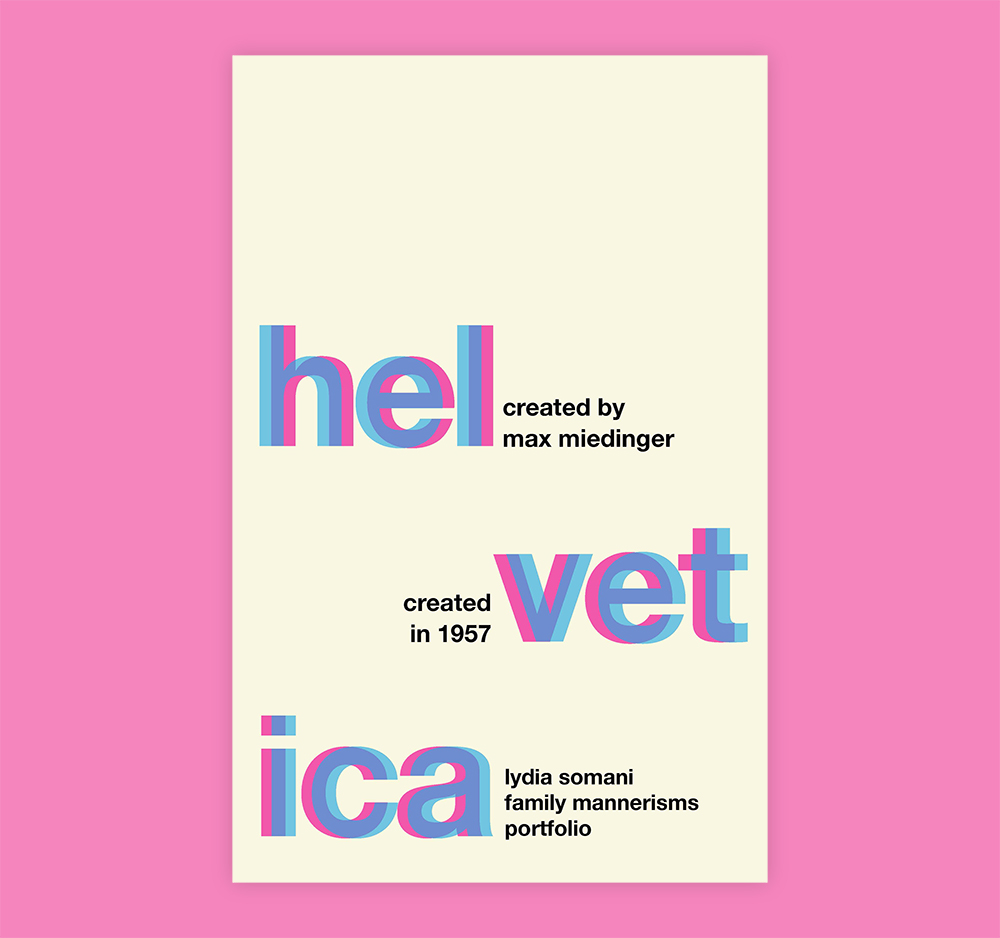










The Font Mannerism Portfolio is a project that I treat more as a series of exercises, to replace some of our more formal exercises that taught specific typography skills in isolation. The Mannerism Portfolio allows students to learn typographic principles and skills while conducting an in-depth study of one particular typeface through examination of its classification and history, character sets, styles, formal attributes, letterform anatomy features, and its contextual usage. I pair this with readings and discussions about connotative and denotative meaning as well as the study of historical type classifications, and type anatomy. I’ve noticed the project allows for deeper discussions and learning opportunities that did not always exist in the purely formal exercises used when I took over the course.
TROPE




This project, titled “Not a Type Specimen” asks students to identify a “typographic trope”, and then recreate the trope as a type specimen. This challenges students to think critically about how typography in our environments embody messages that send cultural signals through packaging, media, and just about anything that we consume in our society that includes language. The project forces students to understand the different types of roles that typography serves in these contexts, from branding and messaging about the product to informative information such as nutrition facts and barcode numbers.
ALBUM & LYRIC
ANIMATION





In this ever popular project, students are asked to redesign an LP package. After selecting an album, students are asked to listen carefully to the album and create a mind map based off themes that they find in the music. They then conduct typographic studies around these themes, then put it all together in the package. A recent addition to this project addresses hierarchy in motion, with a lyric animation. Students learn how to create basic animations using illustrator and photoshop.
SYMPOSIUM POSTER
& WEBSITE



In this poster project, students work together in groups to concept a Symposium on a subject that they know little about. They are then required to pull content together using real leading experts in the field and their infomation. With all the content generated by the group, each student takes on their own design for a poster and website with this information. This introduces them to the typogrpahic problems that arise when dealing with informational text in both print and web formats.
Design VII:
Systems Design
DESIGNING FOR
HEAT EMERGENCIES
IN PHILADELPHIA
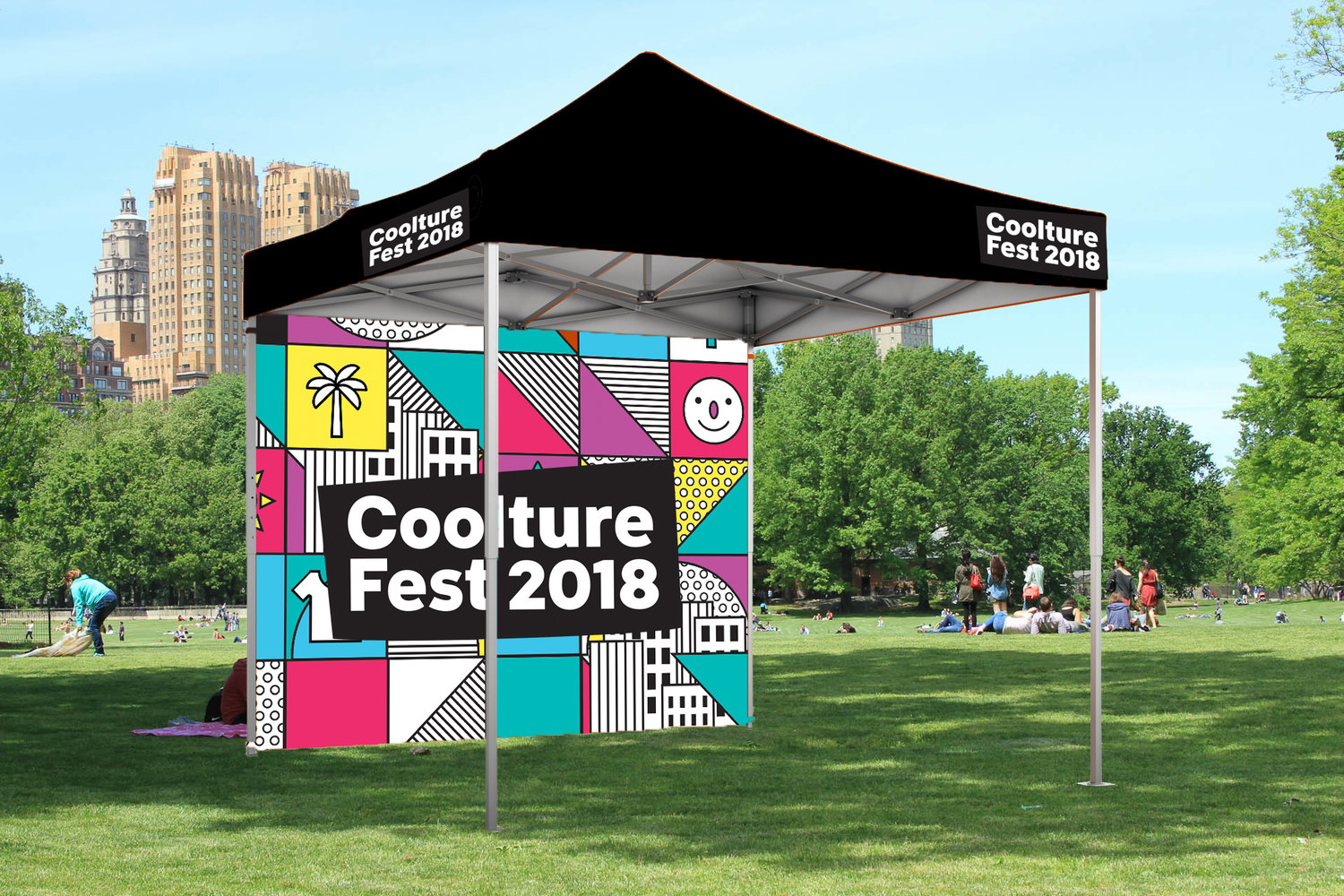








In a collaboration with the Philadelphia Department of Public Health students were tasked with creating a design system that would help Philadelphians’ better prepare for rising temperatures. This semester long project consisted of an extensive research phase that required students to conduct their own human centered research before and during the design process.
CONTROVERSY







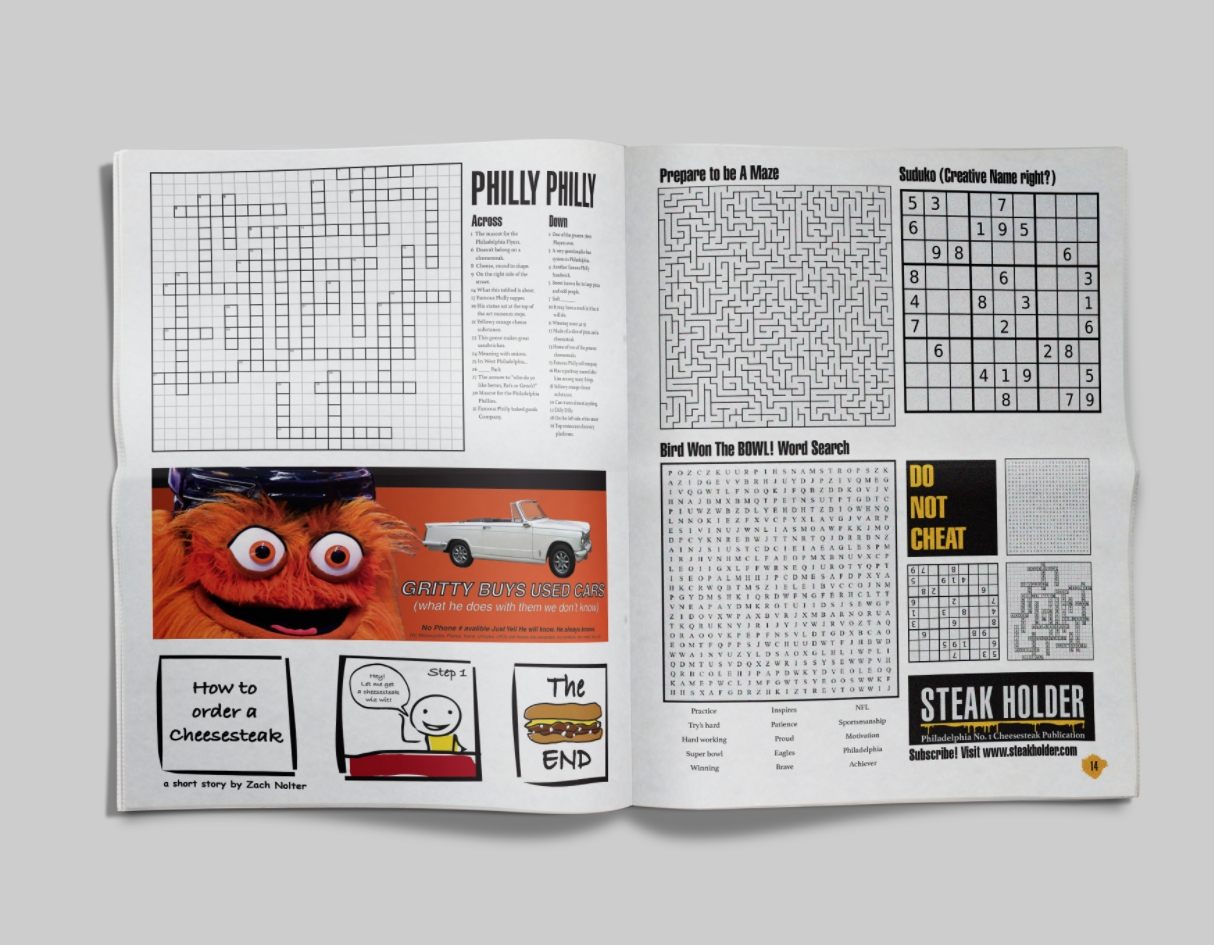
Issues in Information Design
COVID-19 REPORT


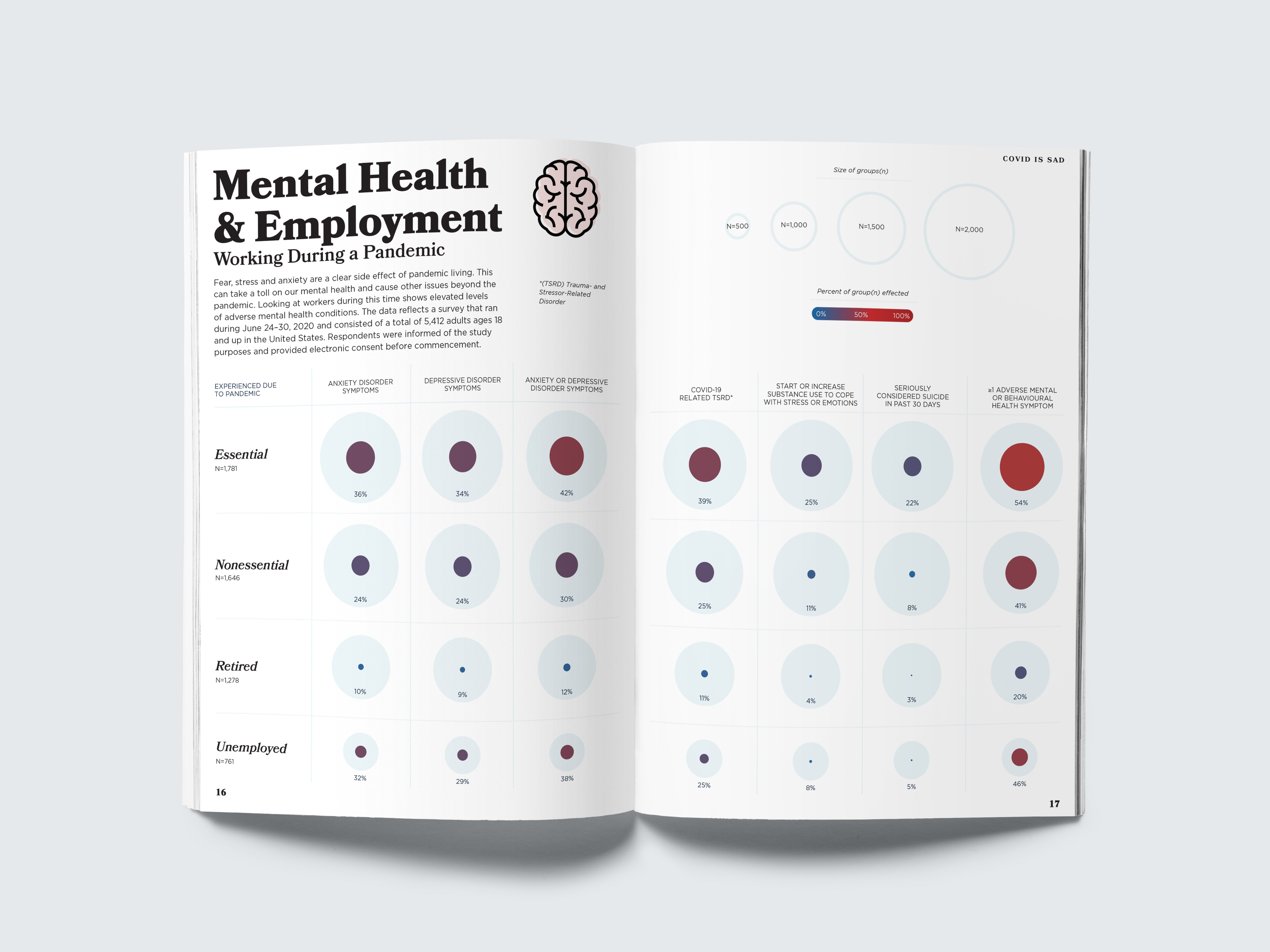


We have all become accustomed to looking at charts that graph the toll COVID-19 has on the human population and the healthcare system. But what about everything else that this pandemic has affected? Students of the Undergrad Visual Communication Design elective Issues in Information Design and the Master’s elective Communicating Health Data came together to use data and design to ponder this question. Thorugh study of the pandemics’ peripheral effects, they uncovered how these effects shape and influence our culture, society, economic, and social behaviors.
BIODIAGRAM





This project introduces students to the basics of creating a diagram. We start by learning the five basic principles of organization for information—Location, Alphabet, Time, Catagory, and Hierarchy. Students then use these organization methods to construct a diagram that tells a story about themselves.
CARTOGRAPHY

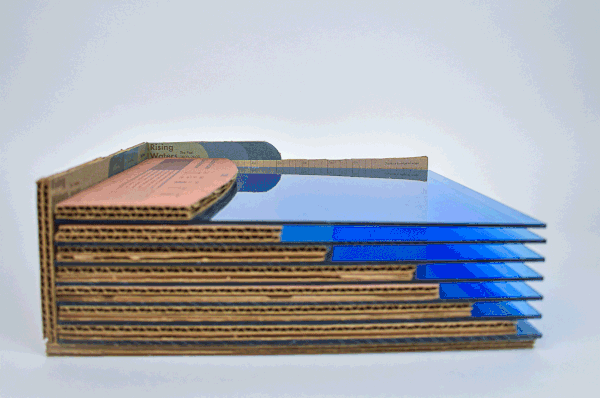

For this project, students chose a uncharted territory to map. It can be a conversation, a natural phemnomena, a social network, or painting. The format is up to them, they are encouraged to explore physical, digital, and motion based solutions.
COMMUNITY HEALTH
REPORT




In a collaboration with the Jefferson Center for Urban Health, students each took on a topic covered in the report and represented the data provided in a visual explanation. Solutions ranged in approach from visual breakdowns of languages spoke by the community to maps displaying economic density in Philadelphia’s neighborhoods. A dissection of the sodium levels the Philadelphians’ favorite cheesesteak helped make the content relatable to the community. Students collaborated to come up with a look and feel for publication in a broadsheet format.
Experiential Graphic Design
ABINGTON HOSPITAL PEDIATRIC UNIT




This collaborative project developed around an opportunity funded by the Joy in Childhood Foundation to improve a pediatric unit at Abington Hospital. The need was to make their space more appealing to teen patients through the design of three environments, including two patient rooms and one waiting room. Working in teams, each group developed concepts, conducted research on teen patients and environments of care, and prepared preliminary documentation for an experiential design within that space. Teams created ideas around nature as a healing environment, creating a comfortable, home-like space to relieve anxiety, and engaging patients in narrative and play to address patient boredom. Surfaces incorporating graphics included walls, windows, shades, and floors. Many solutions merged digital and physical experiences such as customizable projections on ceilings that display different views of the sky, gardens cared for using AR phone technology, and dry erase walls with illustrations for coloring and word puzzles.
3D LETTERFORM




SIGNS









Determine a place / thing / situation where you feel a sign could help. Design a (temporary) sign, or signs. The sign must be designed for use somewhere in the public realm. Consider your target audience, who will use/see your sign(s). Fabricate or render your sign and document it in use.